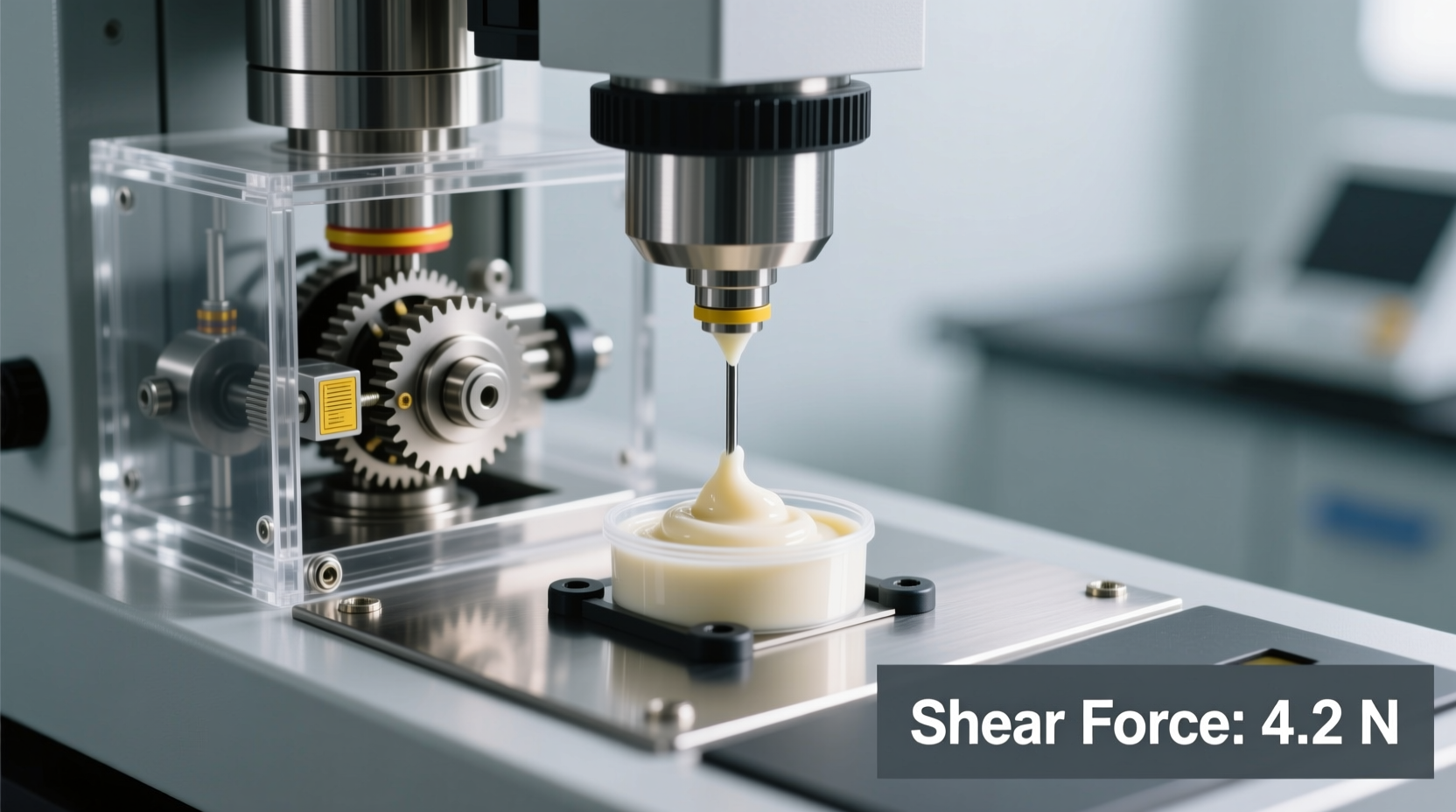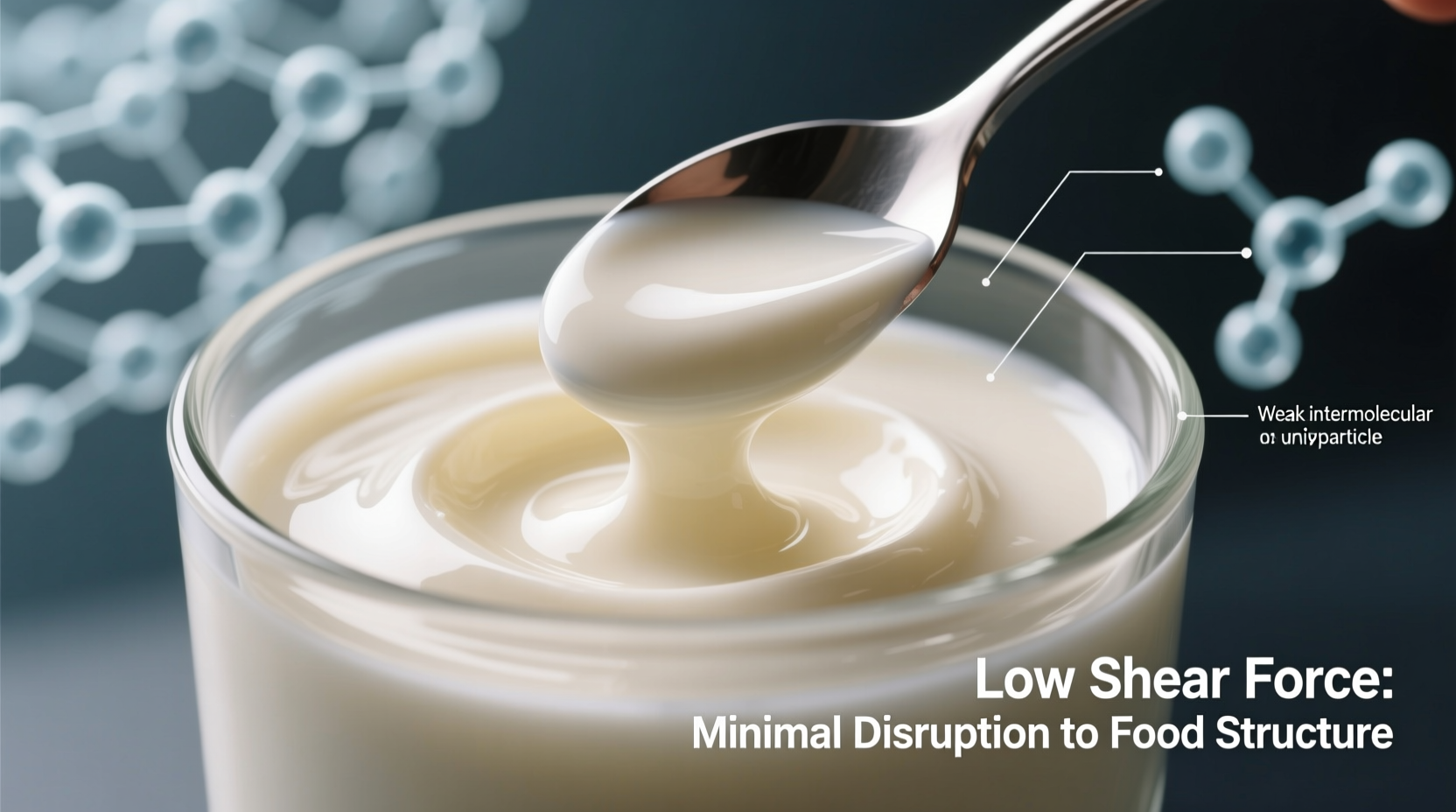Understanding shear force isn't just for food scientists - it's the hidden factor that determines why your béchamel sauce flows perfectly or why that expensive steak melts in your mouth. When foods exhibit low shear force characteristics, they respond gently to mechanical stress, creating textures that delight consumers and simplify manufacturing processes.
What Shear Force Means in Practical Food Terms
Shear force measures how much pressure a food can withstand before deforming or breaking. In food science, we're examining how materials respond when layers slide against each other - think of spreading peanut butter on bread or cutting through a slice of cake.
When a food demonstrates low shear force, it means:
- Minimal resistance when spreading, cutting, or chewing
- Easy breakdown under mechanical stress
- Smooth texture without graininess or toughness
- Fluid behavior even at room temperature
This property becomes especially important when developing products where texture directly affects consumer satisfaction. Food manufacturers carefully measure shear force to ensure consistent quality across production batches.
| Food Category | High Shear Force Examples | Low Shear Force Examples |
|---|---|---|
| Dairy Products | Aged cheddar, feta cheese | Brie, cream cheese, yogurt |
| Meat Products | Steak jerky, tough cuts | Pulled pork, tenderloin, pâté |
| Sauces & Spreads | Peanut butter (natural) | Mayonnaise, béchamel, hollandaise |
| Baked Goods | Bread crust, bagels | Cake crumb, muffins, brownies |
How Low Shear Force Affects Your Cooking Experience
When you're working in the kitchen, low shear force properties determine how ingredients behave during preparation and consumption. Consider these everyday scenarios:
For home cooks: When making mashed potatoes, achieving that perfect low shear force means your potatoes spread easily on a spoon without resistance. Overworked potatoes develop higher shear force, becoming gluey and difficult to spread. The ideal texture requires just enough mechanical action to break down structure without activating too much starch resistance.
In professional kitchens: Chefs rely on low shear force properties when creating delicate sauces. A properly emulsified hollandaise maintains low shear characteristics, flowing smoothly from a spoon while still holding its structure. This balance comes from understanding how egg yolks and butter interact under specific temperature and mechanical conditions.
According to research from the Institute of Food Technologists, shear force measurements provide critical quality control parameters for food manufacturers. Their studies show that consumers consistently prefer meat products with shear force values below 4.5 kgf (kilogram-force), correlating with what we describe as "tender" in everyday language.
The Science Behind Texture Perception
When you bite into food, your teeth apply force that deforms the food structure. Low shear force foods require less energy to break down, creating that desirable "melt-in-your-mouth" sensation. This property depends on several factors:
- Ingredient composition: Proteins like gluten create higher shear resistance, while fats and moisture reduce it
- Processing methods: Cooking techniques that break down structure (braising, slow cooking) decrease shear force
- Temperature: Many foods like chocolate show dramatically lower shear force when warmed
- Particle size: Finer particles generally create lower shear force products
The USDA's Agricultural Research Service has documented how shear force measurements correlate with sensory evaluation of meat tenderness. Their research shows that shear force testing provides the most reliable objective measurement of meat texture, directly impacting consumer satisfaction ratings.

Practical Applications for Better Results
Understanding low shear force principles helps solve common kitchen challenges:
Problem: Grainy cheese sauce that doesn't flow smoothly
Solution: Increase shear force reduction by processing at optimal temperature (140-160°F) while incorporating sodium citrate, which helps break down casein structure for lower shear properties
Problem: Tough meat in slow cooker recipes
Solution: Extend cooking time to break down collagen into gelatin, significantly reducing shear force. The American Meat Science Association recommends cooking tougher cuts to an internal temperature of 190-205°F for optimal shear force reduction.
Problem: Separating vinaigrette that won't stay emulsified
Solution: Incorporate a small amount of Dijon mustard, which contains compounds that reduce interfacial tension, creating a more stable low shear force emulsion.
Troubleshooting Texture Issues
When your food isn't achieving the desired low shear properties, consider these common culprits:
- Insufficient processing time: Many ingredients need adequate mechanical action to reach optimal low shear state
- Temperature issues: Working with ingredients outside their ideal temperature range affects shear properties
- Ingredient ratios: Incorrect fat-to-water ratios prevent proper low shear structure formation
- pH imbalance: Acid levels significantly impact protein structure and shear resistance
Food technologists at major manufacturers use rotational viscometers to measure shear force at various speeds, creating flow curves that predict how products will behave during processing and consumption. For home cooks, developing a tactile understanding of these principles through practice provides similar benefits without specialized equipment.
Advanced Considerations for Food Professionals
For those working in food development, understanding the relationship between shear rate and viscosity becomes critical. Many foods exhibit shear-thinning behavior - their viscosity decreases as shear rate increases. This explains why ketchup flows more easily when you shake the bottle (applying higher shear) but holds its shape on your plate (low shear conditions).
The European Food Safety Authority recognizes shear force measurements as essential quality indicators for various food categories. Their guidelines specify acceptable shear force ranges for products like infant formula and medical nutrition products, where texture directly impacts safety and usability.











 浙公网安备
33010002000092号
浙公网安备
33010002000092号 浙B2-20120091-4
浙B2-20120091-4